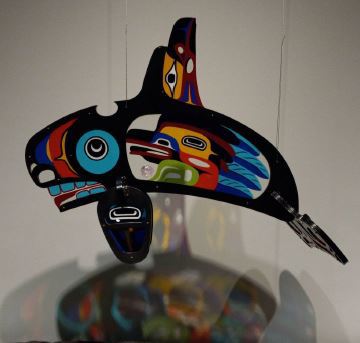Mystical Journey Prototype

Tabac Basket Set with Drawing Shards and Oxblood Body Wraps, 2008, Dale Chihuly (American, b. 1941), blown glass, Courtesy of Chihuly Studio, © Dale Chihuly
Verbal Description
Hello, I’m Emily Holtrop, the museum’s director of learning and interpretation. I will be sharing a description of Mystical Journey Prototype by Marvin Oliver in Clearly Indigenous: Native Visions Reimagined in Glass.
Marvin Oliver was of Quinault and Isleta Pueblo heritage. He lived from 1946 to 2019. His work, Mystical Journey Prototype from 2006, is fused and cast glass and aluminum. It is in the collection of Brigette Ellis.
Mystical Journey Prototype is a three-dimensional sculpture created from fused and cast glass and aluminum. It is displayed suspended and in the round in a freestanding case with three other objects, including Pa’huk Site, also featured in this exhibition’s accessible audio content. The work measures 18 inches tall, 30 inches wide, and 48 inches deep, or 45.7 centimeters tall, 76.2 centimeters wide, and 121.9 centimeters deep. This sculpture is in the form of an orca or killer whale. Multi-colored panes of glass, framed with black, make up the whale’s head, body, and fins. On the head are a blue eye and a mouth open to display a red tongue, and a row of blue teeth are visible. The snout is decorated with red, blue, and orange stripes of varying widths. The body contains an inset of shapes and symbols in several colors, including blue feathers and bird-like forms. Polychrome shapes also decorate the dorsal (top), pectoral (side), and caudal (rear) fins.
Label Audio
Hello, I’m Emily Holtrop, the museum’s director of learning and interpretation. I will be sharing the label for Mystical Journey Prototype by Marvin Oliver in Clearly Indigenous: Native Visions Reimagined in Glass.
Marvin Oliver was of Quinault and Isleta Pueblo heritage. He lived from 1946 to 2019. His work, Mystical Journey Prototype from 2006, is fused and cast glass and aluminum. It is in the collection of Brigette Ellis.
Marvin Oliver created Mystical Journey in 2006 for the Seattle Children’s Hospital, where the 26-foot-long sculpture floats at the top of a three-story atrium. For both the prototype featured here and the monumental sculpture, Oliver cut pieces from colorful glass sheets, fused the pieces together to create a single sheet, and then floated it in a metal frame. The design reflects traditional motifs of Indigenous Peoples who live in the Pacific Northwest.
